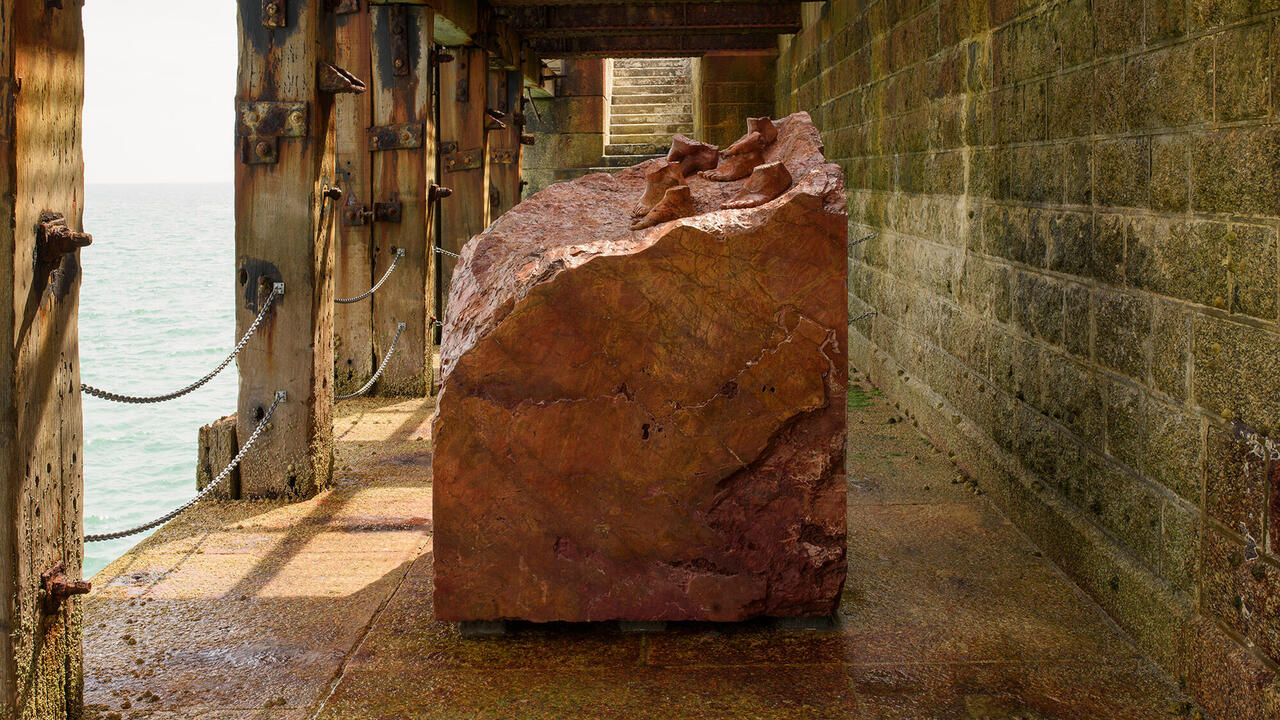Jonathan Baldock Cultivates an Unearthly Garden of Delights
The artist’s oversized flowers at Stephen Friedman Gallery, London, address ideas of inheritance and nurture
The artist’s oversized flowers at Stephen Friedman Gallery, London, address ideas of inheritance and nurture

Spring has come early in Jonathan Baldock’s solo show, ‘we are flowers of one garden’, at Stephen Friedman. On the walls of the exhibition space, outsized blooms flourish, their sackcloth petals spoking from brightly glazed ceramic discs, their stuffed-linen root systems trailing across the black floor, as though they’ve been pulled up by some huge, unseen hand. These plants belong to no species known to botany. Indeed, their generative pistils and stamen have been replaced by, or perhaps mutated into, human countenances, cast from the faces of the British artist and his septuagenarian mother – a woman who taught him many of the craft techniques he employs in his work, and who has long cultivated her own modest garden in the village where Baldock spent his formative years.

This, then, is an exhibition about roots, nurturing and budding into (creative) flower, in which sculptures formed from clay and textiles emphasize their origins as earth and vegetable matter. Nevertheless, it is neither a wholly bucolic vision nor a straightforwardly autobiographical exercise. In the exhibition text, the artist says that he’d like his anthropomorphized flora ‘to look like they could perhaps eat you’, and in Wildflowers don’t care where they grow (all works 2022), there’s a whiff of both the cursed mandrake root and the walking carnivorous plants from John Wyndham’s post-apocalyptic novel The Day of the Triffids (1951). Here, Baldock’s features emerge grimacing from the centre of a yolky yellow bloom, his mouth stuffed with dried chamomile, as though to calm him from some terrible, hungry rage. On a different, albeit no less disquieting note, in And I refused to just wither in place, a long pink ceramic tongue spools from his mother’s mouth, while her face is framed by what look less like petals than glossy scarlet labia. Growth may be one phase of organic existence, but it is bracketed by sex and death – two things which Baldock’s flowers, with their unsettlingly mobile root systems, appear all-too ready to provide.

The cycle of life is as close to an eternal theme as it gets, and to make it feel fresh is no small challenge. The artist’s witty formal invention certainly helps. Consider They were common and close, I had no room for growth, a white stoneware vessel with a pregnant belly that sprouts a pair of cast hands and feet expressing contrary, if connected, emotional states: the former an exuberant ‘jazz hands’ gesture, the latter toe-curling embarrassment (which extremities belong to son, and which to mother, is left deliciously unclear). Another factor is how Baldock’s identity as a gay man scrambles any dully heteronormative readings of these works’ dynamics, familial or otherwise. Much as this exhibition is preoccupied with what we inherit, and bequeath, through nature and nurture, it also has more universal concerns. While the show’s titular ‘garden’ is, in one sense, the self, in another, it’s our wide, shared world.

If this world has a deity, then perhaps it’s Mother Flower: a totemic, stuffed-fabric bloom whose pink face is tattooed with green floral motifs borrowed from European folk art. In the gallery where she hangs, the sound work Just a wild rambling rose seeking mysteries untold (a collaboration with Luke Barton) swells from a set of speakers. Amid amniotic throbs, mother and son sing Dolly Parton’s track ‘Wildflowers’ (1987), and Baldock’s late grandfather plays the accordion. Looking closer at Mother Flower, we might notice she’s chewing on a mouthful of dried roses, consuming dusty, bitter petals as she breathes out sweet perfume. Maybe her divine wisdom is that we should focus on cultivating our garden and leave the imponderable questions of life and death, the ‘mysteries untold’, to her.
Jonathan Baldock’s ‘we are flowers of one garden’ is at Stephen Friedman Gallery, London, until 25 February
Main image: Jonathan Baldock, And I refused to just wither in place (detail), 2022. Ceramic stoneware, hessian, boning, stuffing, natural amethyst, dimensions variable. Courtesy: © Jonathan Baldock and Stephen Friedman Gallery, London; photograph: Todd-White Art Photography























